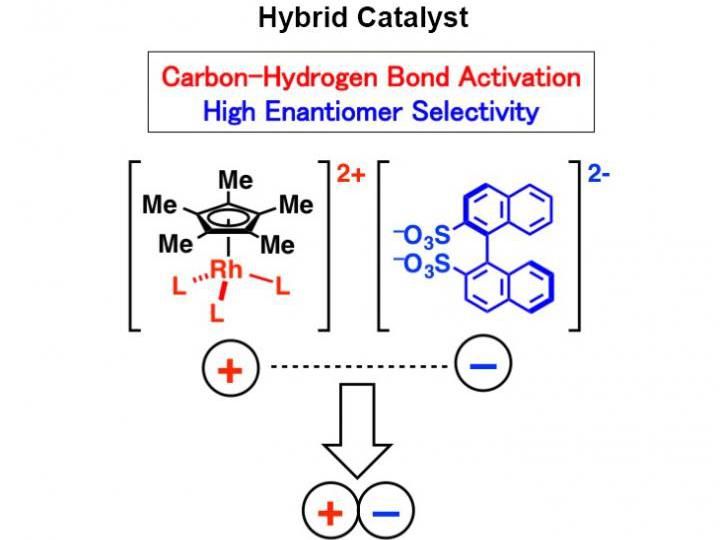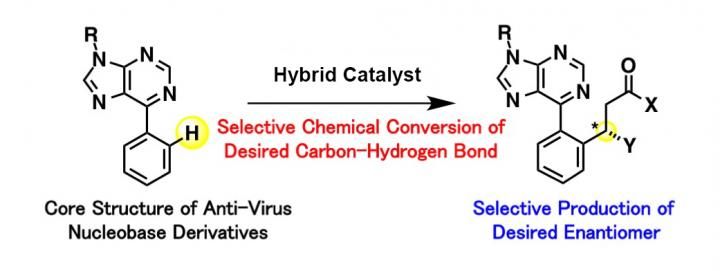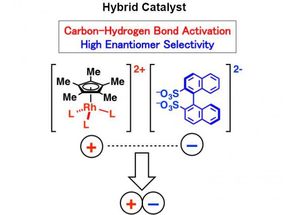Hybrid catalyst with high enantiomer selectivity
A group of Japanese researchers has developed a technology to create a hybrid catalyst from simple-structured, commercially available rhodium and organic catalysts, which reduces chemical waste and produces molecules with high selectivity of an enantiomer, a pair of molecular structures that are non-superimposable mirror images of each other. This technology is expected to assist in rapid and low-cost drug synthesis.

The hybrid catalyst is formed by combining a simple-structured, commercially available rhodium and a readily available organic catalyst through ionic interactions.
Hokkaido University

The hybrid catalyst activates only the targeted carbon-hydrogen bond and yields one molecular structure in the enantiomer when conducting chemical conversions of nucleobase derivatives, which are expected to boost antiviral performance.
Hokkaido University


The technology was developed by scientists including Professor Shigeki Matsunaga and Assistant Professor Tatsuhiko Yoshino, both of Hokkaido University's Faculty of Pharmaceutical Science, and Professor Kazuaki Ishihara and Associate Professor Manabu Hatano, both of Nagoya University's Graduate School of Engineering.
The two molecular structures found in an enantiomer have different effectiveness when used as drugs, even though their chemical properties are similar. One molecular structure can be effective, while the other can trigger serious side effects. It is therefore important to select the desired molecular structure for chemical conversion when synthesizing drugs. In addition, to manufacture medicines with less waste, it is necessary to have the chemical conversion occur only at a desired carbon-hydrogen bond with the use of catalysts. To fulfill these two requirements, scientists have been using expensive rhodium catalysts made in complex, multi-phased production processes. The limited availability of such rhodium catalysts has made it difficult to apply them for industrial use.
In the present study simple-structured, commercially available rhodium was combined with a readily available organic catalyst in one step by utilizing ionic interactions. A simple rhodium catalyst is capable of activating the desired carbon-hydrogen bond, but it's not good at selectively obtaining only one molecular structure in an enantiomer. Organic catalysts, meanwhile, are capable of producing the targeted molecular structure, but are not effective in activating the desired carbon-hydrogen bond. This newly developed hybrid catalyst is able to compensate for both individual shortcomings. Using the hybrid catalyst, the researchers succeeded in activating only the targeted carbon-hydrogen bond and selectively obtaining one molecular structure in the enantiomer when conducting chemical conversions of nucleobase derivatives, which is expected to boost antiviral performance.
"The technology is highly versatile because a variety of organic catalysts can be combined with the simple rhodium catalyst," says Shigeki Matsunaga. "It is expected to help make core chemical structures for nucleotide medicine, which is gaining attention as a next-generation medicine to treat a number of conditions cheaply and in an environmentally friendly way."
Original publication
Most read news
Original publication
Shun Satake, Takumaru Kurihara, Keisuke Nishikawa, Takuya Mochizuki, Manabu Hatano, Kazuaki Ishihara, Tatsuhiko Yoshino & Shigeki Matsunaga; "Pentamethylcyclopentadienyl rhodium(III)–chiral disulfonate hybrid catalysis for enantioselective C–H bond functionalization"; Nature Catalysis; 2018
Topics
Organizations
Other news from the department science

Get the chemical industry in your inbox
By submitting this form you agree that LUMITOS AG will send you the newsletter(s) selected above by email. Your data will not be passed on to third parties. Your data will be stored and processed in accordance with our data protection regulations. LUMITOS may contact you by email for the purpose of advertising or market and opinion surveys. You can revoke your consent at any time without giving reasons to LUMITOS AG, Ernst-Augustin-Str. 2, 12489 Berlin, Germany or by e-mail at revoke@lumitos.com with effect for the future. In addition, each email contains a link to unsubscribe from the corresponding newsletter.


























































